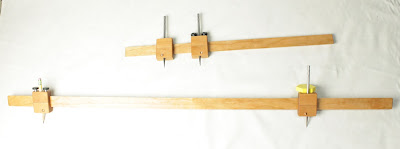First, for those unfamiliar with slingshots, I'll explain a bit about pouches and bands. A pouch is what the projectile sits in, the bands are the stretchy part. Sometimes slingshots use tubes instead of bands, which are the same in principle but the former is a straw shape and the latter is a flat shape. Tubes usually last longer before breaking, and bands usually are more efficient (shoot faster).
People with too much time and too few responsibilities in life will often try to make their slingshots shoot faster and more accurately. Intuition tells us to put bigger bands on the slingshot, but this only works sometimes. It usually helps shoot heavy projectiles faster, such as a 14mm steel ball or larger. Generally though, the fastest (velocity) slingshots have thin, light, long bands cut in a certain shape, with the lightest pouch possible, the densest projectile, and the warmest weather. Thin bands and a light pouch are also relatively easy to pull back, and they don't hurt your hand when they spring back. There are many other variables too, but these are some of the important ones.
All this comes at a cost, in this case it's durability. The slingshots which push the limits of speed might only last ten shots before the bands/pouch break.
I only have the patience to fix my slingshot every couple hundred shots, but I still want a fast slingshot so that I can write long winded blog entries about it and sleep soundly at night.
To make the otherwise light pouch more durable, I sew a knot thing into it which takes some of the strain off the leather. To help keep the thin bands from tearing, I put silicone grease on them every 20 shots or so. The bands usually break where they attach to the pouch, so I attach them carefully with a very thin (Theraband yellow) strip of latex wrapped in a certain way. This requires four hands, two to hold the work and two to tie the tie. Some people can do it with just two; I am not some people. I made myself a set of two wooden hands to help attach bands with latex rubber instead of string:
It did its job. Kind of fiddly though, for an already too-fiddly job. I needed better hands! So I made this today:
In use
This one has more space for my clumsy fingers to manoeuvre around. It
has big thumb nuts which tighten easily. The springs under the clamps
hold them open until they are tightened, and the screws at the back keep
them from swivelling willy nilly
left and right GOOD GRIEF STAY PUT YOU
INCOMPETENT MUNG BEANS. It is coated in walnut oil and has rims that don't spin. Ladies.
Here is the first pouch hot off the press. Next to it are
cannonballs 4.5mm bb's. It is the smallest one I've made yet. Snappy lil one; can put a steel bb in one side of an aluminum can and out the other.
Tiny pouch attached to this little cherry slingshot, approx 100 mm tall by 70 mm wide. It is meant to shoot bb's and airsoft bb's.
If you scroll back and forth between the two photos quickly it looks like a writhing protozoa. Disclaimer: I don't know what a protozoa is.
I made another from the same pattern, but I carved it differently.




































